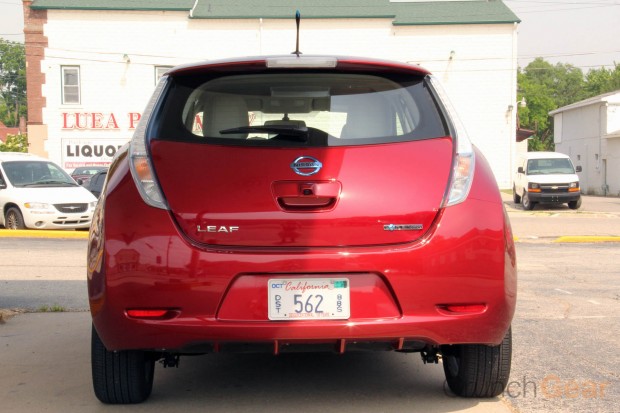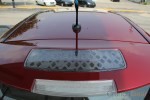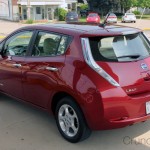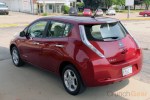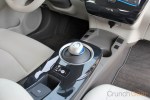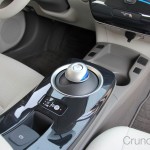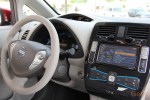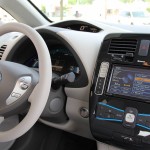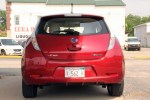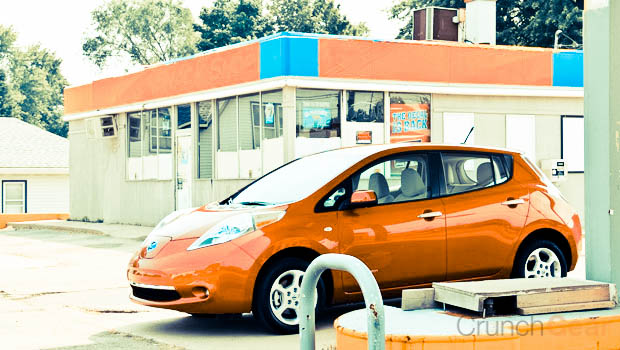
If the road is smooth enough, you can hear birds chirping while you’re going 35 mph. With the windows up. The Nissan Leaf is that quiet. When going less than 30 mph there’s just a slight electric whine from the powertrain and above 45 mph the wheels produces a steady hum. But there’s this special spot between 30 and 45 where the two combine in a way that they cancel each other out and you find yourself moving along listening to Mother Nature’s soundtrack.
The Nissan Leaf has been in my life for the past week. I’ve put hundreds of miles on the tires and ate several meals behind the wheel while trying to figure her out. You see, as much as this pains me to say (more on that later) the Leaf is a real car. It doesn’t feel like a glorified golf cart or tool used just for transportation. It’s a car and with this comes quirks, flaws, but most importantly, a personality and soul.
The Leaf is without equal right now. Nowhere in the world is a vehicle that the Leaf could call a partner, or, if you will, competition. It’s currently the world’s only mass-produced electric vehicle. The Volt? It’s a different sort of vehicle, a hybrid really, that does have an EV mode but it’s limited to 40 miles on electric-only and a gas-powered engine kicks on to power the electric motor after it dies. Tesla? Sure, the Roadster is long range EV, but comes with a price tag north of $100k and a long waiting list. The Leaf is the only choice right now for buyers looking to ditch gasoline entirely while not sacrificing standard creature comforts or cargo room.

Nissan sells the Leaf in ten countries with various different trim levels. I’m driving the US’s SL model which is basically a $940 accessory package masquerading as a different trim level. The SL model doesn’t feature any additional hardware to extend the EV’s limited range; while there’s a tiny solar panel on the rear spoiler, it’s just for keeping the accessory battery topped off.
Step into the Leaf and you’d swear you were in any Japanese econobox. Soft fabric and lots of neutral-colored plastic are used throughout the nondescript interior. It’s roomy with a ton of headroom. The back seats are sort of tight, but are situated higher than the front row (they sit on top of the batteries), which makes for a commanding feel. You wouldn’t guess it by the exterior design, but there’s actually a ton of cargo space behind the back seats, comparable to many smaller crossovers. Unlike Chevy with the Volt, Nissan clearly went to great lengths to make the Leaf non-offensive and look like any other car from the inside.
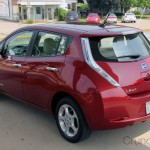 That last statement doesn’t hold true for the exterior design. It’s…unique and I don’t know if in a good way. It’s bubbly but yet angular at the same time. The rear tail lights are taller and sharper than anything ever found on a Cadillac and the smiling front fascia seems to be out of the Pixar movie Cars. I’m not a fan.
That last statement doesn’t hold true for the exterior design. It’s…unique and I don’t know if in a good way. It’s bubbly but yet angular at the same time. The rear tail lights are taller and sharper than anything ever found on a Cadillac and the smiling front fascia seems to be out of the Pixar movie Cars. I’m not a fan.
But I have to say the design is memorable. At first glance it might look like a new Nissan Versa or even a Prius. Then the strong design cues come into focus: the tall and sharp tail lights, the flowing headlamps, and the double hood design that includes the charging port. The Leaf is certainly different.
This is one car where the design doesn’t matter, though. People aren’t buying it around the world because of how it looks. Nope, they’re buying it because it’s an electric vehicle that’s actually practical.
Electric vehicles are nothing new. Ferdinand Porsche made the first electric car in 1899 and nearly every automaker has produced several since. GM’s EV1 was the world’s first mass-produced electric vehicle and was leased from 1996 to 1999. Toyota sold the RAV4 EV for several years and a partnership with Tesla Motors is bringing it back. Then there are countless coach-built EVs, pumped out by dozens of companies around the world.
The Leaf is simple. It has an advertised range of 100 miles and works like any other car. That “keep it simple, stupid” mantra allows Nissan to effectively sell this vehicle across ten different markets to all types of buyers. The interior isn’t loaded with inductive buttons or a radically different instrument cluster (like in the Chevy Volt) or a massive Nvidia-powered touchscreen infotainment system (like in the Tesla Model S). The Leaf is just another car but one that runs on electricity instead of gas.
During my week with this leaf, I spent an afternoon testing the Leaf’s city driving range and found the batteries lasted for 90 miles on Eco mode. That’s 10 less than the advertised range, but this is somewhat common from what I can tell. The Internet is filled with reports of the Leaf not living up to Nissan’s claims. During my test, I drove on congested city roads for four consecutive hours and never exceeded 45 mph. I believe most of the time I was somewhere between 20 and 30 mph.

I fully stand by this 90 mile claim although a 10% positive or negative variance is appropriate. I conducted the test with the goal of squeezing every mile out of the batteries. I drove without the headlamps or climate control. I even kept the radio’s volume low although the on-board Leaf battery meter said that was pointless and didn’t reduce the draw on the battery; I wanted to make sure I was giving this Leaf a fair chance.
90 miles is a fine distance, but I believe that four hours of city driving is a better metric. I drove all over my county. I took the time to see parts of my city I never had a reason to visit. I ran out of places to go. It was this length of time rather than the actual distance that sold me on the Leaf’s real capabilities.
The Leaf knows it isn’t for everyone. The limited range restricts it from traveling the country. But it doesn’t mind bumming around town. Commuting, running errands, going to school; the Leaf can handle all of that. It was built for all of that.
I live in a suburb of Flint, MI. My little test above was conducted primarily within the city proper, which isn’t my normal area or driving conditions. I live out where the roads are long and empty. Well, they’re empty in Flint, too, but in my little town, it’s by design, not from poverty. Out here, the Leaf held its own just as well. There isn’t as much stop and go to recharge the battery through regenerative braking so it didn’t last as long. But never once during the course of my week with the Leaf did I ever feel like I would run short of battery juice.
Highway cruising kills the battery even quicker. While I didn’t perform a dedicated test on highway range due to limited time, I found on several occasions during my week with the Leaf that the battery meter would drop to 50-60 available miles while going the 70 mph speed limit. That gauge isn’t a definitive counter like a gas gauge. It tells the driver how much longer the Leaf will travel based on current driving conditions. So during my few highway trips, when the meter showed 50 available miles while traveling 70 mph, it would raise 10 or so miles when I exited the freeway and dropped my speed.

Charging the Leaf is rather simple. It ships with a 25-foot 110/120V charging cable, but owners should invest in the 220/240 station that charges the Leaf in one third the time. Charging a completely dead battery takes 22 hours on the 110 but only 7h30 on the 220v. I had issues charging the Leaf but it was totally my garage’s fault. The Leaf requires grounded outlets which apparently mine are not. It’s something worth considering before you buy, or else like me you might have a cable draping out of your kitchen window for a week.
Forget about the range for a minute. There were plenty of trips where I knew I had plenty of, let’s say, volts in the tank. The Leaf is fun. The electric powertrain serves up ample torque so the Leaf is actually zippy. The tiny tires aren’t performance rubber so whipping around traffic isn’t the best idea, but if you floor the accelerator, your head will find the headrest rather quickly. Nissan doesn’t provide 0-60 stats but many have found it to 60 mph in around 7 seconds. That’s quick.
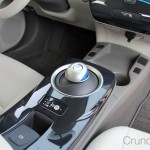 The Leaf isn’t without flaws, though. The tall stance and tiny tires makes for somewhat wobbly, awkward driving characteristics. It’s not a weekend racer. Stomping on the electric motor while rounding a curve will result in an “OMG I’m rolling over” reaction even though the front wheel drive configuration helps correct overcompensation. It feels like so much more could come from the torquey electric motor.
The Leaf isn’t without flaws, though. The tall stance and tiny tires makes for somewhat wobbly, awkward driving characteristics. It’s not a weekend racer. Stomping on the electric motor while rounding a curve will result in an “OMG I’m rolling over” reaction even though the front wheel drive configuration helps correct overcompensation. It feels like so much more could come from the torquey electric motor.
The inoffensive interior is, in a way, actually offensive — at least to me. It’s grey on grey with just a hint of personality. It really looks like a mashup of every Japanese budget car built in the last 10 years. The only little bit of fun comes from the gear selector, which is a little four-way blue puck. It actually looks a bit out of place, although the low-profile design works well.
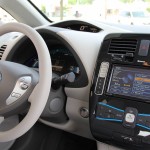
The onboard infotainment system is at least well developed. The large touchscreen features navigation, media controls, and plenty of information regarding the electrical systems. The key info screen (pictured directly above) shows the motor and electrical system’s current draw on the battery. Want to know how much turning on the AC will affect the battery? It says on that screen (5 miles in the picture above).
The radio and media capabilities are like any found on a modern tech-equipped sedan. There’s XM/Sirius, AM/FM, Bluetooth audio streaming and a CD player. The speakers are flat and lifeless — not that anyone is expecting to bump Kottonmouth Kings from their Leaf.
A fun part of the Leaf ecosystem comes in the form of an companion iOS app. This lightweight app allows owners to manage
g times and monitor battery life. They can also schedule notifications concerning available range and charging status. Strangely though, the app doesn’t allow for remotely unlocking or locking of the vehicle like the apps found in GM cars. It’s just for the electric powertrain. An Android flavor is apparently in the works, but right now it’s just an iOS app.
Now as much as I like the Leaf, it is clearly a low-cost vehicle but one with an expensive powertrain. It lacks a lot of features traditionally standard in a vehicle that costs over $30k. Among many minor items, the notable ones missing are power-adjustable seats, a telescoping steering column, adjustable pedals, and a power liftgate. Some of these options were probably left out as a weight-saving measure, but buyers should know going in that the Leaf does not spec-out well with features at the same price point.
Future models will at least gain a heated steering wheel and seats. As a Nissan rep told me, these options use less battery than the traditional cabin heating system. Heat the right contact points and you heat the body, he said. Chevy knows this, too. The Volt features both of those options standard and is the only vehicle GM sells with heated cloth seats.
I’m totally sold on the Leaf. In my mind, it’s the perfect second car. I have two young kids who happen to sit in massive car seats. They fit fine in the leaf. It’s a fine people mover. But it doesn’t get much better than running around town for next to free. That’s what I really like.
I put 355 miles on the Leaf last week. In my Dodge Magnum, which gets 17 mpg in the city, I would have used about 20 gallons of gas; at $3.50 per gallon, that comes to around $70. The Leaf’s battery capacity is 24kW and my local power company charges .072567 per kWh. That means it only costs me ~$1.74 to charge the Leaf from empty to full for which I did a total of three times with a couple of charges only topping off the battery — but let’s say four full charges to make this math easy. That means the Leaf only cost me $7.01 to drive the 350 miles — alternatively, think of it as 50 miles for every $1. Of course this is my rate and your mileage will differ depending on the cost of electricity but it should be within a few dollars, and it sure isn’t going to be as much as gas.
The Leaf isn’t perfect, with its $33,000 window sticker being one of the main downfalls. It’s expensive yet still feels cheap on the inside. But it’s fun, practical, and if you look at the back-end cost of gas, the car is rather cost effective. Many city drivers could probably foot the bill of the Leaf in just the gas savings alone. As long as buyers go into the Leaf knowing that they’re not going to get all the creature comforts they’re used to, the Leaf is a fine vehicle.
At least the Leaf isn’t missing anything in the fun department. The electric motor has enough oomph to make most smile while zipping people around town. It comes with all the media bells and whistles with XM, Bluetooth streaming, and so on, all done through a large touchscreen.
So here I am, swallowing my pride and recommending the Leaf. You see, like I stated a couple posts back, I’m supposed to be a Chevy Volt fan. Hailing from the fine city of Flint, which happens to be the birthplace of General Motors, I’ve constantly championed the Volt’s unlimited range and justified the $40,000 price tag while ragging on my fellow editor Devin for covering what I thought was the lame Leaf. This admission doesn’t diminish the the Volt’s strengths, but the Leaf’s pure electric powertrain costs nearly nothing to run, making it the perfect city car. Highly recommended.
